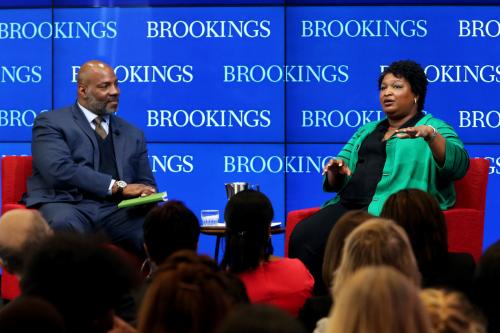 Voter suppression has persisted throughout America’s history and continues to manifest itself in many forms. People of color, particularly African-Americans, as well as youth and low-income voters, have disproportionately experienced practices that keep them from the polls. When Georgia gubernatorial candidate Stacey Abrams narrowly lost the race to incumbent Georgia secretary of state in the 2018 midterm elections, a national conversation examining this problem and the importance of voting rights was reignited.
Voter suppression has persisted throughout America’s history and continues to manifest itself in many forms. People of color, particularly African-Americans, as well as youth and low-income voters, have disproportionately experienced practices that keep them from the polls. When Georgia gubernatorial candidate Stacey Abrams narrowly lost the race to incumbent Georgia secretary of state in the 2018 midterm elections, a national conversation examining this problem and the importance of voting rights was reignited.
On February 15, Abrams joined The New Yorker’s Jelani Cobb in a conversation hosted by Brookings to discuss the systematic disenfranchisement of voters of color in the U.S. and explore measures that may change this narrative.
The architecture of voter suppression
Moderator Jelani Cobb, the Ira A. Lipman Professor of Journalism at Columbia University and regular contributor to The New Yorker, began the dialogue by asking about the mechanisms that comprise voter suppression and how they function.
Abrams, the first African-American woman to run in a Georgia gubernatorial race and who would have become the first African-American female governor in America, said that “voting is directly tied to the services and policies that you want to see. Voter suppression acts as means of denying those policies’ reality, and it is baked into the DNA of America.” She noted that voter suppression expresses itself in three ways: registration access, ballot access, and ballot counting. Abrams added that the bureaucracy of elections such as “use it or lose it laws,” absentee ballots never arriving, and officials throwing votes away all contribute to voter suppression.
Voter suppression: De jure to de facto
The conversation moved to how this form of discrimination can still persist in today’s society. Abrams highlighted the fact that for a portion of America’s history, voter suppression could legally exist, de jure, but after the 1965 Voting Rights Act was passed, suppression became quieter, de facto.
Abrams explained how voter suppression continued in subtle ways such as long lines that cut into paychecks for every hour lost waiting to vote, lack of provisional ballots due to insufficient supplies, and unethical election processes.
Abrams noted that what Georgia Secretary of State Brian Kemp, who won the gubernatorial contest, did “was entirely legal and wholly wrong.” But, “because the law permits it, the remedies are limited unless you have people who are in power who say this law should be changed.”
Next steps in fighting voter suppression
After describing some of the injustices that influence elections, Abrams commented on her current mission to combat voter suppression. “For me,” she said, “the response to sorrow—the response to anger—is action.” She explained that her organization, Fair Fight Action, is responsible for providing a voice for the underrepresented by addressing problems in Georgia’s electoral system, and her personal mission includes legal action against unfair elections, a push for better legislation, and advocacy work to ensure that people vote.
Cobb asked about Abrams’ experience mobilizing voters in 2018. Abrams explained that the key is to begin outreach early, build a diverse team that represents the entirety of the community, and fund conversations from the ground up. She noted that she increased the black voter turnout during her election and received more votes than any Democrat in Georgia history simply by giving a platform to the marginalized members of society.
A response to President Trump’s declaration of a state of emergency
Before opening up the panel for questions, Cobb asked Abrams to comment on another national debate: President Trump’s declaration of a state of emergency along the U.S.-Mexico border, which occurred during the event, as a means to secure funding for his proposed border wall. Abrams responded that this announcement does not merit an answer, and that ignoring it denies President Trump an audience.
The full event audio and video are available on the event’s webpage.
Mimi Cottingham contributed to this post.




Commentary
WATCH: Stacey Abrams on how to address voter suppression
February 15, 2019